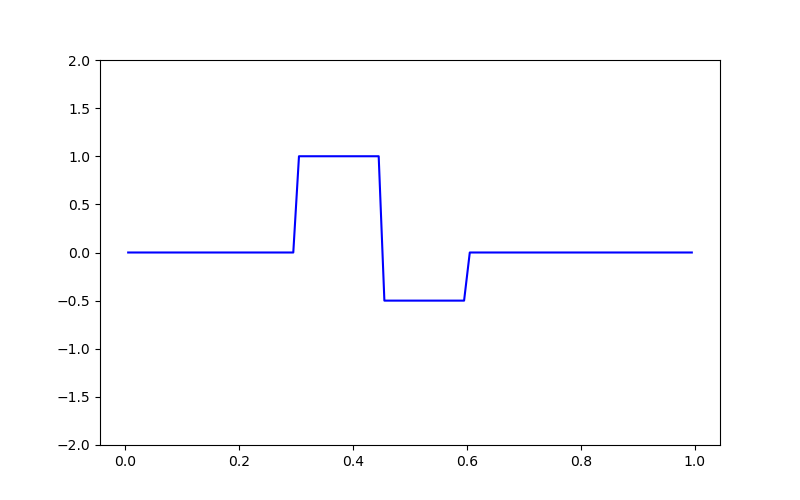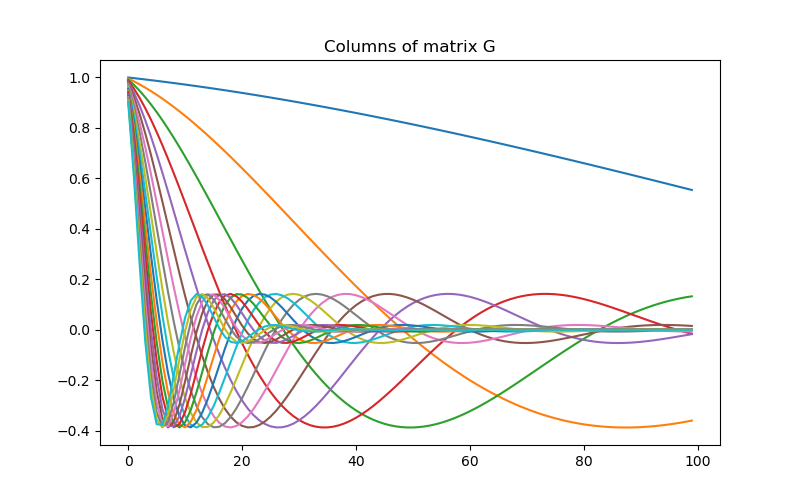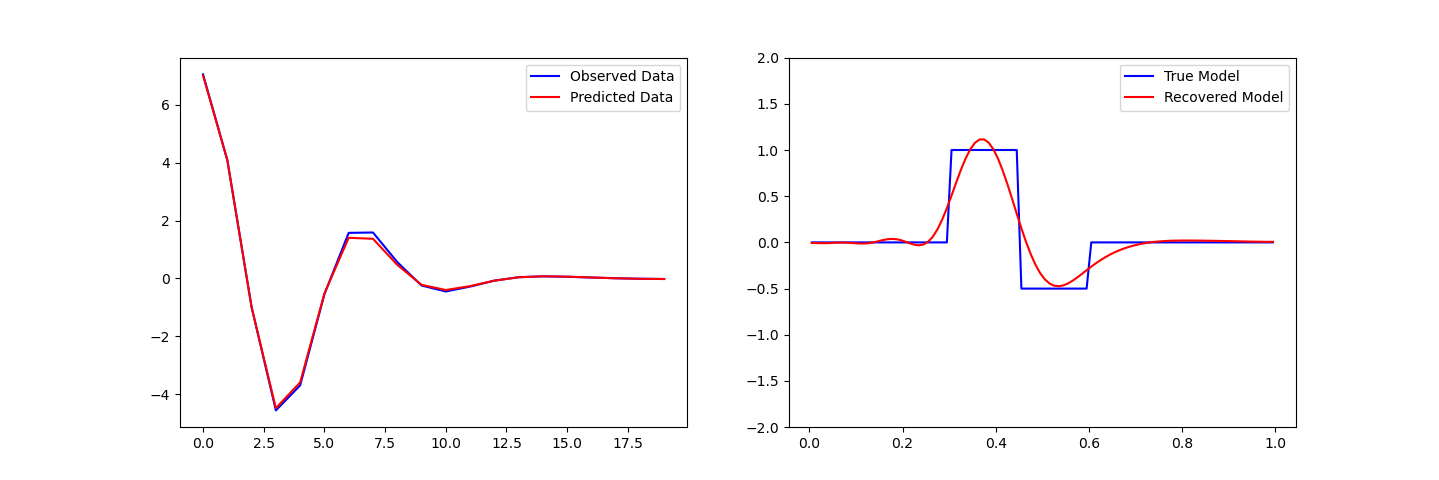Note
Go to the end to download the full example code.
Linear Least-Squares Inversion#
Here we demonstrate the basics of inverting data with SimPEG by considering a linear inverse problem. We formulate the inverse problem as a least-squares optimization problem. For this tutorial, we focus on the following:
Defining the forward problem
Defining the inverse problem (data misfit, regularization, optimization)
Specifying directives for the inversion
Recovering a set of model parameters which explains the observations
Import Modules#
import numpy as np
import matplotlib.pyplot as plt
from discretize import TensorMesh
from simpeg import (
simulation,
maps,
data_misfit,
directives,
optimization,
regularization,
inverse_problem,
inversion,
)
# sphinx_gallery_thumbnail_number = 3
Defining the Model and Mapping#
Here we generate a synthetic model and a mappig which goes from the model space to the row space of our linear operator.
nParam = 100 # Number of model paramters
# A 1D mesh is used to define the row-space of the linear operator.
mesh = TensorMesh([nParam])
# Creating the true model
true_model = np.zeros(mesh.nC)
true_model[mesh.cell_centers_x > 0.3] = 1.0
true_model[mesh.cell_centers_x > 0.45] = -0.5
true_model[mesh.cell_centers_x > 0.6] = 0
# Mapping from the model space to the row space of the linear operator
model_map = maps.IdentityMap(mesh)
# Plotting the true model
fig = plt.figure(figsize=(8, 5))
ax = fig.add_subplot(111)
ax.plot(mesh.cell_centers_x, true_model, "b-")
ax.set_ylim([-2, 2])

(-2.0, 2.0)
Defining the Linear Operator#
Here we define the linear operator with dimensions (nData, nParam). In practive, you may have a problem-specific linear operator which you would like to construct or load here.
# Number of data observations (rows)
nData = 20
# Create the linear operator for the tutorial. The columns of the linear operator
# represents a set of decaying and oscillating functions.
jk = np.linspace(1.0, 60.0, nData)
p = -0.25
q = 0.25
def g(k):
return np.exp(p * jk[k] * mesh.cell_centers_x) * np.cos(
np.pi * q * jk[k] * mesh.cell_centers_x
)
G = np.empty((nData, nParam))
for i in range(nData):
G[i, :] = g(i)
# Plot the columns of G
fig = plt.figure(figsize=(8, 5))
ax = fig.add_subplot(111)
for i in range(G.shape[0]):
ax.plot(G[i, :])
ax.set_title("Columns of matrix G")

Text(0.5, 1.0, 'Columns of matrix G')
Defining the Simulation#
The simulation defines the relationship between the model parameters and predicted data.
Predict Synthetic Data#
Here, we use the true model to create synthetic data which we will subsequently invert.
# Standard deviation of Gaussian noise being added
std = 0.01
np.random.seed(1)
# Create a SimPEG data object
data_obj = sim.make_synthetic_data(true_model, relative_error=std, add_noise=True)
Define the Inverse Problem#
The inverse problem is defined by 3 things:
Data Misfit: a measure of how well our recovered model explains the field data
Regularization: constraints placed on the recovered model and a priori information
Optimization: the numerical approach used to solve the inverse problem
# Define the data misfit. Here the data misfit is the L2 norm of the weighted
# residual between the observed data and the data predicted for a given model.
# Within the data misfit, the residual between predicted and observed data are
# normalized by the data's standard deviation.
dmis = data_misfit.L2DataMisfit(simulation=sim, data=data_obj)
# Define the regularization (model objective function).
reg = regularization.WeightedLeastSquares(mesh, alpha_s=1.0, alpha_x=1.0)
# Define how the optimization problem is solved.
opt = optimization.InexactGaussNewton(maxIter=50)
# Here we define the inverse problem that is to be solved
inv_prob = inverse_problem.BaseInvProblem(dmis, reg, opt)
Define Inversion Directives#
Here we define any directiveas that are carried out during the inversion. This includes the cooling schedule for the trade-off parameter (beta), stopping criteria for the inversion and saving inversion results at each iteration.
# Defining a starting value for the trade-off parameter (beta) between the data
# misfit and the regularization.
starting_beta = directives.BetaEstimate_ByEig(beta0_ratio=1e-4)
# Setting a stopping criteria for the inversion.
target_misfit = directives.TargetMisfit()
# The directives are defined as a list.
directives_list = [starting_beta, target_misfit]
Setting a Starting Model and Running the Inversion#
To define the inversion object, we need to define the inversion problem and the set of directives. We can then run the inversion.
# Here we combine the inverse problem and the set of directives
inv = inversion.BaseInversion(inv_prob, directives_list)
# Starting model
starting_model = np.zeros(nParam)
# Run inversion
recovered_model = inv.run(starting_model)
Running inversion with SimPEG v0.25.1.dev1+g9a8c46e88
============================ Inexact Gauss Newton ============================
# beta phi_d phi_m f |proj(x-g)-x| LS Comment
-----------------------------------------------------------------------------
0 1.85e+02 2.00e+05 0.00e+00 2.00e+05
1 1.85e+02 9.34e+04 6.98e-01 9.36e+04 2.43e+06 0
2 1.85e+02 6.42e+04 2.60e+00 6.47e+04 1.57e+05 0
3 1.85e+02 3.74e+04 9.50e+00 3.92e+04 1.26e+05 0 Skip BFGS
4 1.85e+02 2.51e+04 9.46e+00 2.69e+04 9.15e+04 0
5 1.85e+02 1.77e+04 1.50e+01 2.04e+04 1.22e+05 0
6 1.85e+02 8.66e+03 2.37e+01 1.30e+04 7.36e+04 0
7 1.85e+02 6.55e+03 2.41e+01 1.10e+04 7.05e+04 0
8 1.85e+02 5.25e+03 2.59e+01 1.00e+04 5.13e+04 0
9 1.85e+02 4.12e+03 2.76e+01 9.23e+03 1.49e+05 0
10 1.85e+02 2.52e+03 3.18e+01 8.40e+03 1.01e+05 0
11 1.85e+02 2.26e+03 3.24e+01 8.26e+03 8.99e+04 0 Skip BFGS
12 1.85e+02 2.27e+03 3.19e+01 8.17e+03 6.99e+04 0
13 1.85e+02 2.06e+03 3.28e+01 8.13e+03 9.39e+04 0
14 1.85e+02 1.87e+03 3.28e+01 7.93e+03 9.95e+04 0 Skip BFGS
15 1.85e+02 1.94e+03 3.19e+01 7.84e+03 1.45e+05 0
16 1.85e+02 1.84e+03 3.17e+01 7.69e+03 1.02e+05 0 Skip BFGS
17 1.85e+02 1.83e+03 3.16e+01 7.67e+03 9.35e+03 0
18 1.85e+02 1.67e+03 3.18e+01 7.56e+03 6.34e+03 0
19 1.85e+02 1.38e+03 3.30e+01 7.48e+03 2.08e+04 0 Skip BFGS
20 1.85e+02 1.41e+03 3.27e+01 7.45e+03 2.36e+04 0
21 1.85e+02 1.28e+03 3.33e+01 7.43e+03 9.52e+03 0
22 1.85e+02 1.25e+03 3.34e+01 7.43e+03 4.50e+04 0 Skip BFGS
23 1.85e+02 1.26e+03 3.34e+01 7.42e+03 1.73e+04 0
24 1.85e+02 1.12e+03 3.40e+01 7.41e+03 2.65e+04 0 Skip BFGS
25 1.85e+02 1.20e+03 3.36e+01 7.40e+03 2.02e+04 0
26 1.85e+02 1.21e+03 3.34e+01 7.40e+03 2.38e+04 0 Skip BFGS
27 1.85e+02 1.19e+03 3.36e+01 7.39e+03 4.70e+04 0
28 1.85e+02 1.16e+03 3.36e+01 7.38e+03 2.78e+04 0 Skip BFGS
29 1.85e+02 1.16e+03 3.36e+01 7.38e+03 2.76e+04 0
30 1.85e+02 1.16e+03 3.36e+01 7.38e+03 2.76e+04 0 Skip BFGS
31 1.85e+02 1.16e+03 3.36e+01 7.38e+03 2.77e+04 0
32 1.85e+02 1.07e+03 3.40e+01 7.36e+03 2.76e+04 0 Skip BFGS
33 1.85e+02 1.05e+03 3.40e+01 7.34e+03 1.96e+04 0
34 1.85e+02 1.04e+03 3.40e+01 7.33e+03 1.63e+04 0 Skip BFGS
35 1.85e+02 1.02e+03 3.41e+01 7.33e+03 1.11e+04 0
36 1.85e+02 1.02e+03 3.41e+01 7.33e+03 1.12e+04 0 Skip BFGS
37 1.85e+02 1.02e+03 3.41e+01 7.33e+03 1.65e+04 0
38 1.85e+02 1.02e+03 3.41e+01 7.33e+03 1.64e+04 0
39 1.85e+02 1.02e+03 3.41e+01 7.33e+03 1.54e+04 0
40 1.85e+02 1.02e+03 3.41e+01 7.33e+03 1.85e+04 0 Skip BFGS
41 1.85e+02 1.02e+03 3.41e+01 7.33e+03 1.33e+04 0
42 1.85e+02 1.02e+03 3.41e+01 7.33e+03 1.76e+04 0 Skip BFGS
43 1.85e+02 1.02e+03 3.41e+01 7.33e+03 1.29e+04 0
44 1.85e+02 1.01e+03 3.41e+01 7.33e+03 1.53e+04 0
45 1.85e+02 1.01e+03 3.41e+01 7.33e+03 6.31e+03 0 Skip BFGS
46 1.85e+02 1.01e+03 3.42e+01 7.33e+03 9.18e+03 0
47 1.85e+02 1.01e+03 3.41e+01 7.33e+03 8.29e+03 0
48 1.85e+02 9.94e+02 3.42e+01 7.33e+03 8.95e+03 0 Skip BFGS
49 1.85e+02 9.76e+02 3.43e+01 7.33e+03 8.00e+03 0
50 1.85e+02 9.83e+02 3.43e+01 7.32e+03 6.82e+03 0 Skip BFGS
------------------------- STOP! -------------------------
1 : |fc-fOld| = 4.7965e+00 <= tolF*(1+|f0|) = 2.0000e+04
1 : |xc-x_last| = 6.0383e-02 <= tolX*(1+|x0|) = 1.0000e-01
0 : |proj(x-g)-x| = 4.2975e+03 <= tolG = 1.0000e-01
0 : |proj(x-g)-x| = 4.2975e+03 <= 1e3*eps = 1.0000e-02
1 : maxIter = 50 <= iter = 50
------------------------- DONE! -------------------------
Plotting Results#
# Observed versus predicted data
fig, ax = plt.subplots(1, 2, figsize=(12 * 1.2, 4 * 1.2))
ax[0].plot(data_obj.dobs, "b-")
ax[0].plot(inv_prob.dpred, "r-")
ax[0].legend(("Observed Data", "Predicted Data"))
# True versus recovered model
ax[1].plot(mesh.cell_centers_x, true_model, "b-")
ax[1].plot(mesh.cell_centers_x, recovered_model, "r-")
ax[1].legend(("True Model", "Recovered Model"))
ax[1].set_ylim([-2, 2])

(-2.0, 2.0)
Total running time of the script: (0 minutes 39.425 seconds)
Estimated memory usage: 321 MB
